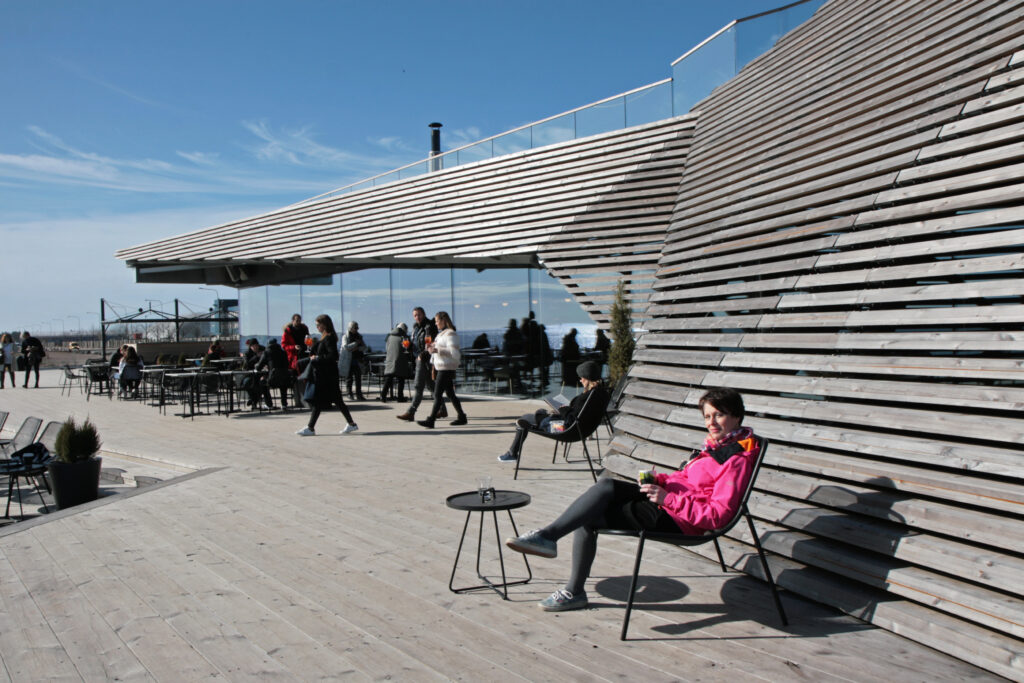Customer orientation to boost wood construction

Wooden structures and even skyscrapers are spreading all over the world and Finland, too, wants to be involved in the green and sustainable timber trend.
Ms Katja Lähtinen, Finnish Professor of Business Economics and Wood Construction, suggests googling the words Bordeaux and CLT. The screen shows a picture of a futuristic wooden tower, looking almost like a living tree. The solid lines constructed from cross-laminated timber are like branches supporting the green balconies.
“Hypérion”, the 18-storey project in Bordeaux, is the first wooden tower in France. News of large, innovative and impressive wooden buildings are currently heard from all over the world: London, Stockholm, Melbourne.
“Interest in timber construction is emerging everywhere, even without the tradition of wood construction that we have in Finland. This is precisely the moment to develop our own expertise and to look for entirely new kinds of timber construction solutions,” says Lähtinen.


Lähtinen’s professorship was set up to develop wood construction from the business perspective. Wood products industry and wood construction traditionally operate locally and on a small scale. The sector is of great significance for regional economies, and even for private forest owners.
“Provided the homework is done properly, the global trends related to sustainable construction and housing will also open up export opportunities”, says Lähtinen.
Location matters
Lähtinen is particularly interested in how people want to live. “Is the Finnish dream of owning a detached house still true or are we just dissatisfied with tower blocks?” she asks. That is, if it was possible to customize a flat the way you do your own house, what would people choose?
Lähtinen believes that many people would rather live in a flat. High-rise buildings are appropriate today, with the megatrend of rapid urbanisation and people looking for a new kind of community. In other words, she would involve the future residents in planning and use that as a means of marketing wooden construction.
A wooden house is known to be a pleasant, quiet and healthy environment. In addition to residential buildings, a growing number of schools and day care centres will be made of wood – Finland boasts an especially great number of public construction projects using logs.
“It is especially in public construction projects that we can argue for the use of wood as a sustainable material. But if you are looking for a new home, the construction material or the sustainability aspects of the material used for the frame are hardly the first criterion; you are much more likely to study the location or the floor plan and their impact on the perceived quality of housing,” Lähtinen thinks.
Local authorities have thus a key role in promoting green and sustainable construction. Planning complexes of several wooden buildings could also create a competitive advantage to attract new residents and businesses. Public wooden buildings would also bring something new to urban architecture.
It’s all about sustainable forest management
Wood construction is a flagship project of the Finnish Government. The aim is to increase industrial wood construction and exports, but also the environmental and climate friendliness of construction. A wooden building acts as a carbon storage throughout its life – even hundreds of years.
From the beginning of next year, Finnish wood construction regulations, such as fire safety regulations, will be relaxed so as to allow wood to compete on an equal footing with concrete and steel.
Lähtinen points out that Finns do not always remember to mention the trump cards of Finnish wood construction, which also include responsible and transparent forestry. In Finland, sustainable forest management has strong traditions and it is safeguarded by legislation.
“We know where the timber comes from and how the forests are managed, even when they are not certified. Of course, with certification we can prove our sustainable use of forests to others,” Lähtinen states.
“Wood construction is part of genuine circulation economy, where new uses for forest industry side-streams are constantly being found. It also links chemical and mechanical forest industry, SMEs and large-scale industry.”
A thousand uses for wood
For long, Finland’s strength in wood construction has been the construction of single-family homes and summer cottages. According to a recent study by the Pellervo Economic Research Institute, more than 80 per cent of detached houses in Finland have a wooden frame and practically all leisure homes are made of wood.
A few per cent of tower blocks in Finland are wooden, but there will be more soon. Each new tower block made of wood makes local news, and a nationwide newspaper recently published a map showing all the 52 multi-storey buildings.
In Finland, industrial wood construction is still young. The first manufacturer of cross-laminated timber, for example, was only established in 2014.
Lähtinen’s mission is to promote the use of wood throughout the built environment, as well as in interiors. Solutions can be found in the wood products industry and the new innovations of the forest sector. Patios can be paved with composite materials and textiles made from pulp fibre.
In construction, Lähtinen would take advantage of the best characteristics of different materials and develop solutions to combine wood, concrete and steel.
“There are buildings where a wood-only frame makes the best sense, but also buildings where a hybrid construction gives the best results,” says Lähtinen.
“A good example of a hybrid construction is Löyly in Helsinki. It is a sauna and restaurant building, where all materials have been left exposed. And that highlights the properties of wood even better,” says Lähtinen.
Kirjoita kommentti